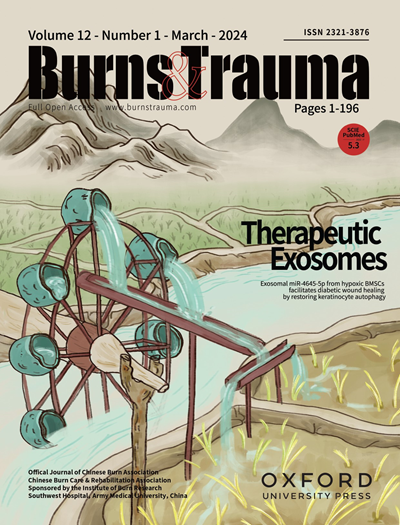葡萄糖代谢在伤口愈合中的作用综述
IF 9.6
1区 医学
Q1 DERMATOLOGY
引用次数: 0
摘要
葡萄糖代谢是细胞获取能量的核心过程,通过糖酵解和三羧酸(TCA)循环提供三磷酸腺苷(ATP)和代谢中间体,支持细胞增殖、迁移和功能维持。它不仅为细胞提供燃料,还通过戊糖磷酸途径产生烟酰胺腺嘌呤二核苷酸磷酸(NADPH)。这种NADPH对于抵御氧化应激、控制免疫反应和在细胞信号传导中发挥作用至关重要。在伤口愈合过程中,葡萄糖代谢在各个阶段都起着至关重要的作用。在早期阶段,细胞依靠糖酵解产生增殖和迁移所需的能量;在炎症期,免疫细胞通过葡萄糖代谢产生活性氧,消灭病原体;在增殖和重塑阶段,葡萄糖代谢支持细胞外基质的生成和组织修复。然而,在慢性伤口中,糖代谢异常会增加氧化应激和炎症反应,显著延缓伤口愈合。了解异常葡萄糖代谢如何影响伤口微环境和细胞功能可以帮助研究人员开发新的治疗策略。因此,这篇综述分解了葡萄糖代谢在伤口愈合的每个阶段是如何工作的。我们正在强调它的潜力,作为我们可以治疗的目标,并希望在未来的研究和临床应用中激发一些新的想法和途径。本文章由计算机程序翻译,如有差异,请以英文原文为准。
The Role of Glucose Metabolism in Wound Healing: an overview
Glucose metabolism is the core process by which cells obtain energy, providing adenosine triphosphate (ATP) and metabolic intermediates through glycolysis and the tricarboxylic acid (TCA) cycle and supporting cell proliferation, migration, and functional maintenance. It not only fuels cells but also cranks out nicotinamide adenine dinucleotide phosphate (NADPH) via the pentose phosphate pathway. This NADPH is crucial for fending off oxidative stress, keeping immune responses in check, and playing a role in cell signaling. During the process of wound healing, glucose metabolism plays a crucial role in each stage. In the early stage, cells rely on glycolysis to generate energy for proliferation and migration; during the inflammatory phase, immune cells generate reactive oxygen species through glucose metabolism to eliminate pathogens; and during the proliferation and remodeling phase, glucose metabolism supports the generation of the extracellular matrix and tissue repair. However, in chronic wounds, abnormal glucose metabolism increases oxidative stress and inflammatory responses, significantly delaying wound healing. Understanding how abnormal glucose metabolism affects the wound microenvironment and cell function can help researchers develop new therapeutic strategies. Therefore, this review breaks down how glucose metabolism works at each stage of wound healing. We're highlighting its potential as something we can target therapeutically, and hoping to spark some fresh ideas and avenues for research and clinical use down the road.
求助全文
通过发布文献求助,成功后即可免费获取论文全文。
去求助
来源期刊

Burns & Trauma
医学-皮肤病学
CiteScore
8.40
自引率
9.40%
发文量
186
审稿时长
6 weeks
期刊介绍:
The first open access journal in the field of burns and trauma injury in the Asia-Pacific region, Burns & Trauma publishes the latest developments in basic, clinical and translational research in the field. With a special focus on prevention, clinical treatment and basic research, the journal welcomes submissions in various aspects of biomaterials, tissue engineering, stem cells, critical care, immunobiology, skin transplantation, and the prevention and regeneration of burns and trauma injuries. With an expert Editorial Board and a team of dedicated scientific editors, the journal enjoys a large readership and is supported by Southwest Hospital, which covers authors'' article processing charges.
 求助内容:
求助内容: 应助结果提醒方式:
应助结果提醒方式:


